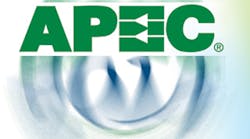The industry’s leading trade show and conference for power electronics, the Applied Power Electronics Conference and Exposition (APEC), will take place this year at the Fort Worth Convention Center, Fort Worth, Texas, from March 16 to March 20, 2014. Sponsored by the IEEE, the conference will once again hone in the key topics affecting power system designers. Some highlights include:
· Technical paper subjects selected by experts from industry and academia covering power converter design and applications, inverters, thermal modeling, magnetic components, motor drives, LED lighting, and vehicular electronics.
· Among the 80 industry session subjects will be industrial power, alternative energy, nanotechnology, vehicle power, wide bandgap devices and packaging.
· Rap sessions will focus on smart infrastructures and wide band gap materials.
· 18 educational seminars will offer topics on Devices, Fundamentals, Emerging Technologies, Design, Modeling, and Control.
· The associated exposition has a record high participation with 221 exhibitors and 337 booths.
The plenary session, to be held Monday, March 17 from 1:30 to 5:00 PM, provides a glimpse into some of the key and emerging areas in today’s rapidly-evolving power landscape through presentations from several speakers.
“Transforming Energy Management,” to be presented by David Freeman, Chief Technical Officer of Power Management at Texas Instruments, examines the topic of power and energy management. Freeman will look at advanced power management strategies developed in the portable world that have been transformed into power technologies for transportation and stationary applications. This includes circuit solutions that minimize losses, and developments in leading-edge semiconductors, circuits, packaging, and manufacturing. They allow designers to take a systems approach to power and energy management, which will help fuel growth for power electronics in markets such as portable, transportation, computing and communication.
|
"Power Electronics In Emerging Applications,” by Dong Tan of Northrop Grumman Corp., looks at Northrop Grumman’s Advanced Electrical Power Systems (AEPS) that features modularity and scalability to minimize cost, schedule and technical risk. Its minimum set of five (5) standard electronic slices allows various units and hence the power system to be configured either as regulated or unregulated bus. Its peak power tracking capability, together with high power conversion efficiency and tightly regulated bus voltage, reduces significantly the required solar array capacity and payload power distribution size and weight for a given mission. |
|
“Mission Critical Power: Past, Present and Future,” by Miguel Chavez, Director of Engineering at Eaton, looks at mission-critical power and how the evolution of industries requiring uninterrupted electric power and advances in power electronics have helped shape its path. From early computer rooms to today’s hyper-scale data centers, the demands for safe and reliable power have grown significantly and are part of a world that expects to be interconnected 24/7. |
|
“ARPA-E Initiatives In High Effficiency Power Conversion,” by Tim Heidel, Program Director for the Advanced Research Projects Agency-Energy (ARPA-E), examines power electronics advances that promise substantial energy efficiency gains across a wide range of power. Over the past four years, ARPA-E has launched several power electronics focused programs including ADEPT (2010), Solar ADEPT (2011), and SWITCHES (2013) programs. |
|
“Significant Developments And Trends in 3D Packaging Of Power Products,” by Brian Narveson and Ernie Parker, Co-Chairman of the PSMA Packaging Committee, looks at the challenges facing the packaged and modular power supply industry to deliver more power in a smaller volume. Their presentation will include the results of a study by the Packaging Committee of the Power Supply Manufactures Association (PSMA) that overviews the technology and product trends that are evolving, what the drivers are and what the market opportunities will be over the coming years. This study identifies R&D and manufacturing challenges that need to be addressed, ranging from chip level integration and silicon stacking to Hi- Power Modules (up to 10 kW). |
|
“Systems Reliability Vs. Efficiency: Are We Being Redundant?” by Brian Fortenbery of the Electric Power Research Institute (EPRI), looks at the tradeoffs systems designers face when building redundancy into their architectures to increase reliability. The problem with this approach is that the use of additional components to shoulder parts of the load decreases system efficiency and increases energy use. This presentation will discuss the pros and cons of this approach, and suggest some alternatives that can increase efficiency and save energy. |

